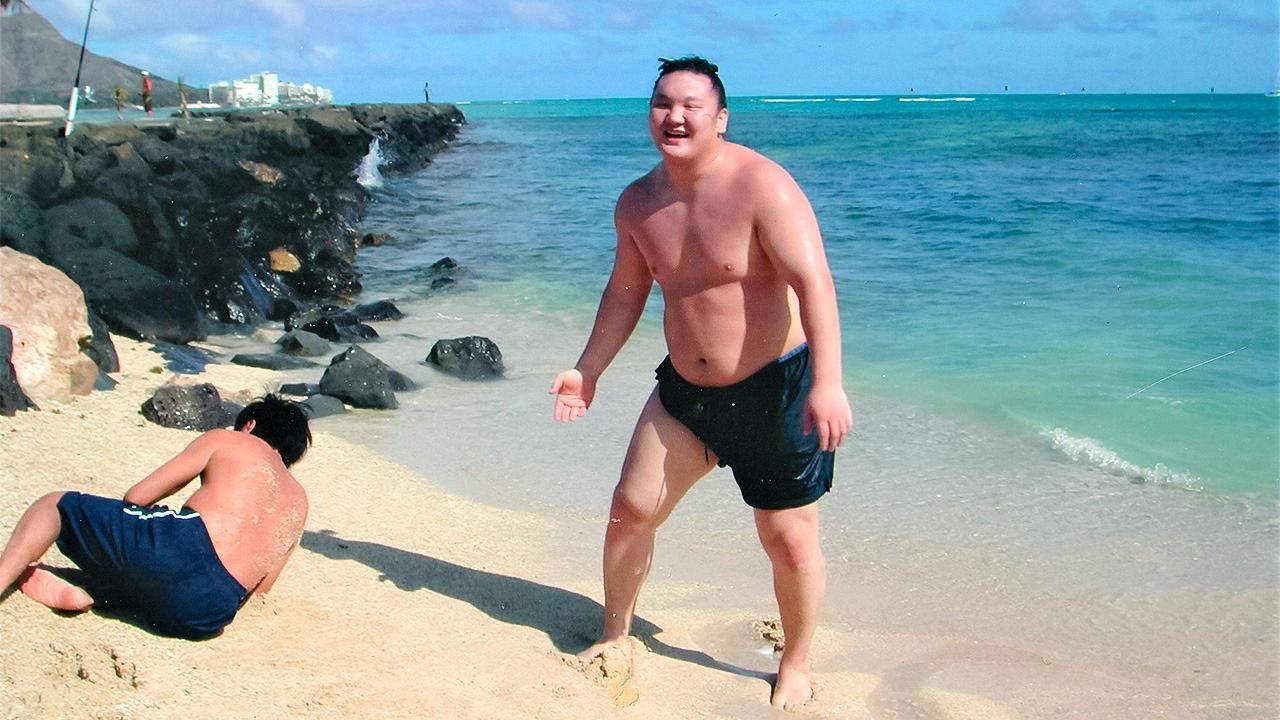
“Yokozuna” Hakuhō: An Intimate Tale of a Sumō Grand Champion
Culture Sports- English
- 日本語
- 简体字
- 繁體字
- Français
- Español
- العربية
- Русский
Small Beginnings
Hakuhō is perhaps the best grappler ever to compete in professional sumō, having broken a string of long-standing records, including notching 1,187 wins and 45 tournament championships over his career, Once, though, he was a 15-year-old arriving in Japan for the first time, with hopes of joining the world of sumō.
Inspired by the exploits of Kyokushūzan, the first Mongolian wrestler to break into the top ranks of the sport, he arrived as a part of a group of five hopefuls. Born Mönkhbatyn Davaajargal in Ulan Bator in 1985, he had wrestling in his blood. His father Jigjidiin Mönkhbat won silver in the middleweight freestyle competition at the 1968 Mexico City Olympics and claimed six Mongolian wrestling national championships, feats that propelled him to the status of national hero. Having grown up hearing about his father’s accomplishments, Hakuhō had high hopes of building a legacy in the sumō ring.
Hakuhō and his fellow Mongolian hopefuls arrived in Japan in October 2000 and trained at the Settsu Sōko Sumō club, one of Japan’s top amateur groups, while waiting to be selected by a heya, or “stable”—a live-in training organization to which wrestlers belong. At 175 centimeters tall and weighing just 62 kilograms, though, the young Hakuhō failed to draw the attention of scouting stablemasters, who passed him over for bulkier prospects. After nearly two months of waiting in vain, he had all but given up hope. However, while preparing to fly back to Mongolia, he received a last-minute offer from the Miyagino-beya, a tiny stable with no wrestlers of note.
The Miyagino stablemaster, former wrestler Chikubayama, saw in the gangly youth an untapped potential and bestowed on him the shikona (ring name) Hakuhō (白鵬) in the hope that he might one day equal the two yokozuna Kashiwado and Taihō, whose great rivalry in the 1960s was given its own designation based on parts of their names, the Hakuhō era.
Expectations, however, would have to wait, as bulking up was the first order of business for the still scrawny rikishi. Hakuhō says that in the beginning, eating took precedence over practice. “All I did was stuff myself,” he recounts with a chuckle. “Even if I felt sick, I knew I’d be in for it if I didn’t keep everything down. It was harder than any training.”
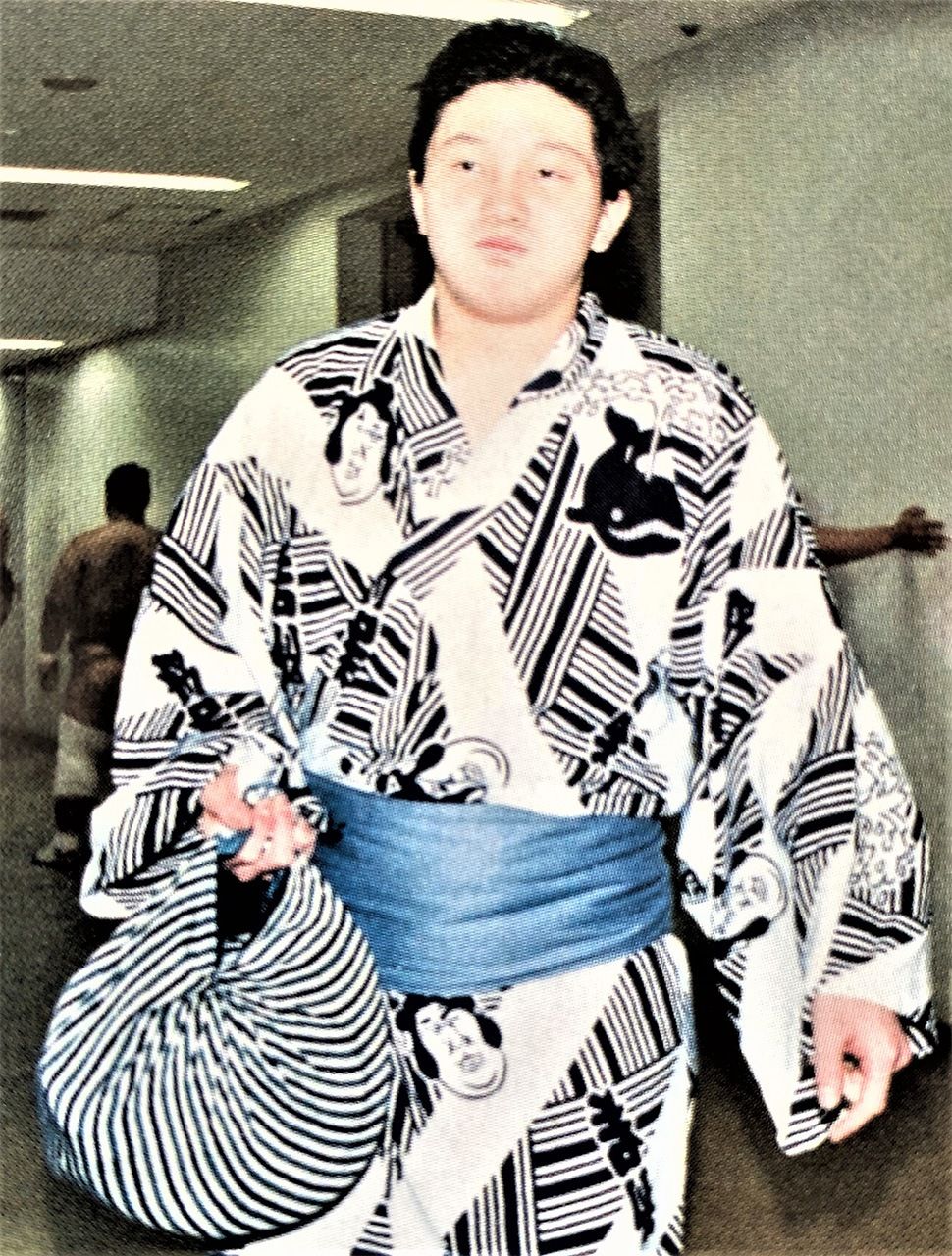
A young, slender Hakuhō after entering the Miyagino-beya. (Courtesy of the author)
Smitten with Sumō
Hakuhō made his debut at the 2001 spring tournament, held in March. In the summer tournament two months later, when he had risen to the jonokuchi division, he notched a lackluster record of 3 wins and 4 losses. This was an uninspiring start, but he threw himself into training, honing the natural talents he had received from his father with hard work in the practice ring. He put in consistently strong performances in later tournaments and shot up through the lower ranks. In 2004, his third year as a wrestler, he broke into the higher makuuchi division, becoming at 19 years and 1 month the fourth youngest rikishi in recent times to earn promotion to sumō’s highest division. He continued his climb in the top flight, quickly working his way to sekiwake, the first of the three top san’yaku ranks, and then to ōzeki, which he achieved by posting a 13-2 record in the 2006 spring tournament.
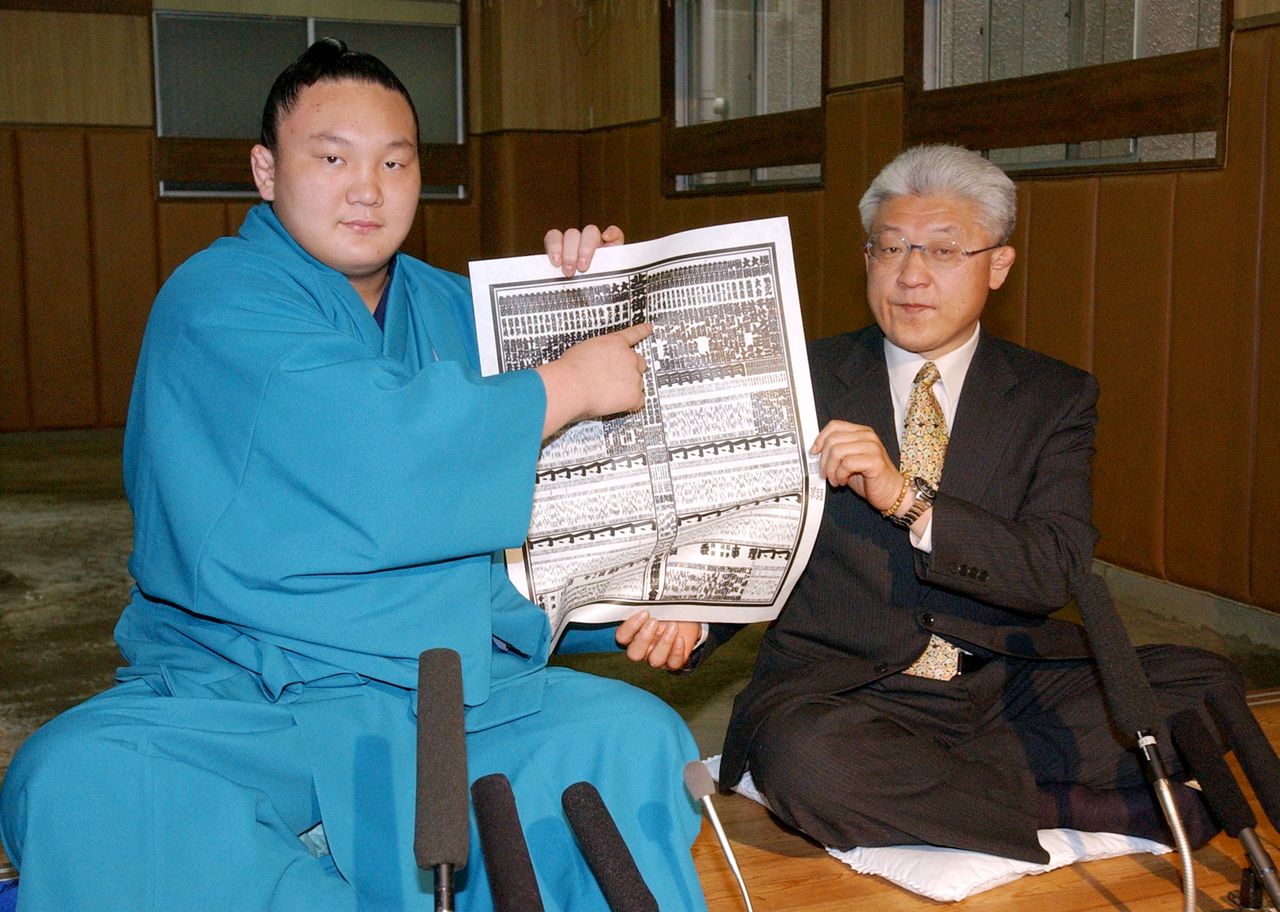
Hakuhō, left, and stablemaster Miyagino celebrate his promotion to the makuuchi division in April 2004 at the Miyagino stable in Sumida, Tokyo. (© Jiji)
Along with distinguishing himself on the dohyō, Hakuhō set himself apart from his fellow wrestlers by his unusually buoyant view of sumō. The ancient sport is notorious for imposing grueling training regimes, and tournaments are long, physically and mentally taxing affairs. Wrestlers typically endure these rigors with stiff upper lips, but from around the time he reached the rank of ōzeki, Hakuhō routinely lauded sumō as “incredibly fun” and would proclaim that he “couldn’t wait for the next tournament.” Such upbeat comments would be unthinkable coming from the mouths of top Japanese wrestlers, but they typified the energy and aspirations of the Mongolian rikishi.
Hakuhō claimed his first title in his maiden outing as ōzeki at the summer tournament in Tokyo in May 2006, finishing with an impressive 14–1 record. He put in another strong performance at the following tournament in Nagoya, but had to settle for runner-up after going down to defeat twice. On the last day of the tourney, though, he thrilled spectators by toppling fellow Mongolian Asashōryū in the final bout, handing the yokozuna his only defeat and dashing his hopes of an unblemished championship. Hakuhō felt certain that his 13–2 record, taken along with his first win, would assure him promotion to the coveted rank of grand champion. Japan Sumō Association director Kaiketsu Masateru, however, felt promotion was premature, saying that Hakuhō needed one more tournament to prove he was yokozuna caliber.
I spoke with Hakuhō alone following the tournament and his disappointment was evident despite his typical upbeat tone. “I was led to believe before the tournament that I would need thirteen wins for promotion,” he confessed. Chuckling, he said he learned that he had been passed over when watching public broadcaster NHK, the next best thing to an official source. “If NHK said it, it had to be true.” I made a feeble attempt to ease his disappointment by explaining how the rules for promotion to yokozuna had been stiffened following the controversy around Futahaguro, who was made grand champion in 1986 but subsequently expelled the following year without ever winning a top division tournament. Hakuhō politely listened to my spiel, although it was obvious that he was not convinced.
Nose to the Grindstone
Knowing there would be other chances to prove himself, Hakuhō quickly moved on from the experience. The summer regional tour season was underway, and the Mongolian wrestler became the center of attention at events.
Seasonal tours date back centuries and have traditionally been run by local promoters. The JSA, however, took over this task to cash in on the popularity of the yokozuna brothers Wakanohana and Takanohana in the 1990s. It subsequently withdrew when public interest in sumō plummeted following a string of scandals, withering revenue. Few promoters committed to holding events, and as a result the normally lengthy summer tour consisted of a mere five one-day stops.
One of the main attractions of regional events is the chance to see rikishi practicing, particularly the mōshiai, a fast-paced exercise involving large groups of wrestlers. Two competitors face off in the ring as the other rikishi look on, with the winner immediately choosing another challenger from the eager throng. Normally, a wrestler continues to spar until they are defeated, but ōzeki and yokozuna are allowed to remain in the ring for as long as they wish. Rikishi typically engage in around 10 mōshiai bouts over the course of the exhausting practice. However, Hakuhō set spectators abuzz by declaring that he would average 20 bouts per event in a bid to log 100 contests over the course of the five-day tour.
At the first stop in Kōriyama, Fukushima Prefecture, he engaged in 13 bouts, losing only once, and at the next event Furano, Hokkaidō, he won all but one of his 17 contests. In Date, Hokkaidō, he picked up the pace on the third day with 19 wins in 21 bouts, but skipped the event on the fourth day after complaining of swelling and pain in his right hand. He was back in action for the fifth and final day in the city of Aomori, which took place out in the open as the mercury topped 30 degrees Celsius.
The mōshiai was to only involve rikishi from the second-tier juryō division, so I thought Hakuhō would miss his chance to fulfill his promise of 100 bouts. He joined at the last minute, though, first taking on a stream of juryō wrestlers before a group of higher ranked rikishi entered the fray, boosting the level of competition. By the time the mōshiai finished, Hakuhō had engaged in an incredible 43 bouts on the final day.
After the training ended, I approached Hakuhō and asked him whether he had reached his goal of 100, to which he replied frankly, “I made it to 94.” He had had five regular matches that day and he joked that these should be added to the tally. “I could have sparred a bit more. But if you take my matches along with all the other training, you could say I made it to 100.” It was a lighthearted comment, but contained a glint of Hakuhō’s reluctance to admit defeat.
Champion Expectations
In 2007, Hakuhō satisfied the requirements for promotion to grand champion with back-to-back titles at the 2007 spring and summer tournaments. At 22 years and 2 months, he was the third youngest wrestler to reach the rank of yokozuna, behind the greats Kitanoumi and Taihō.
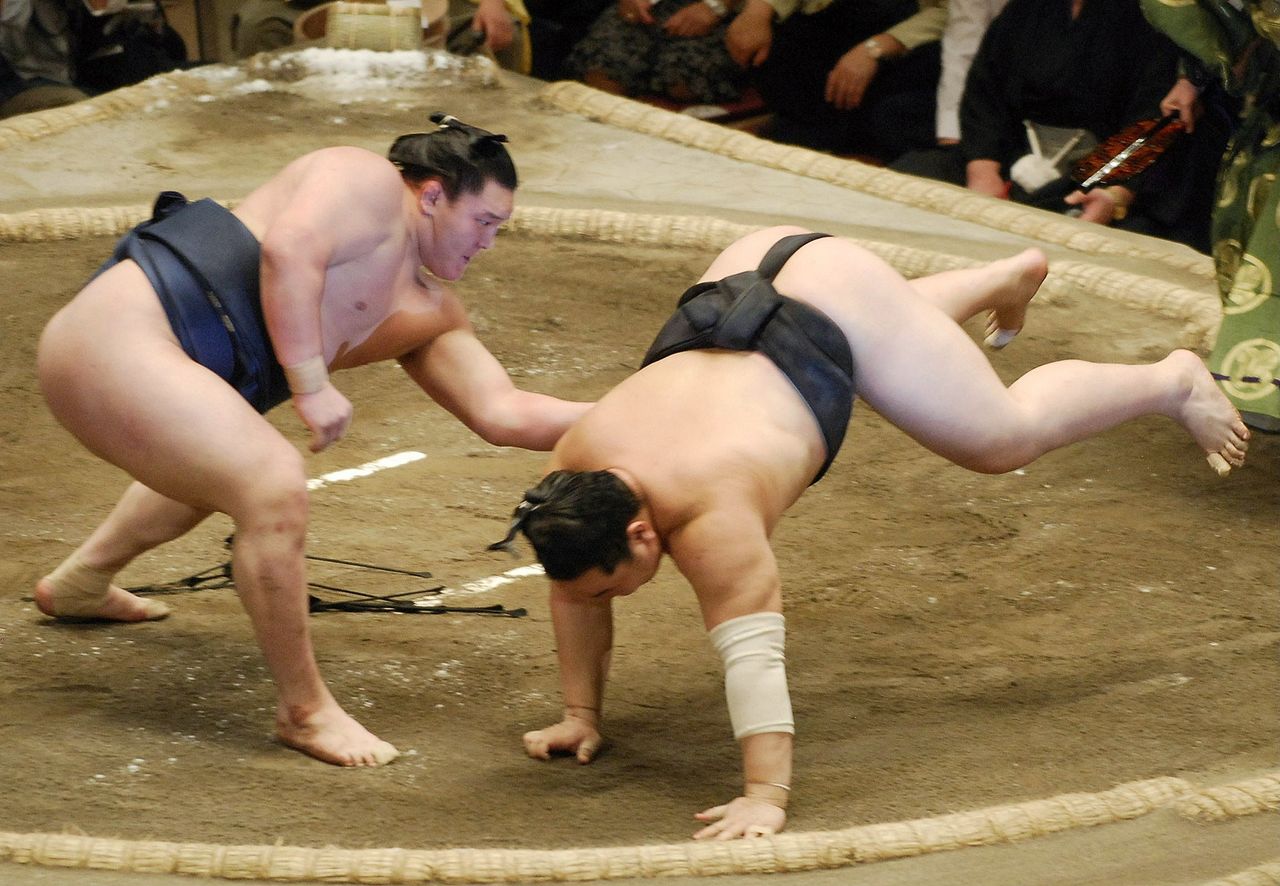
Hakuhō, left, throws Asashōryū in the final bout of the summer tournament on May 27, 2007, to win the title with a perfect 15–0 record and secure promotion to yokozuna. (© Jiji)
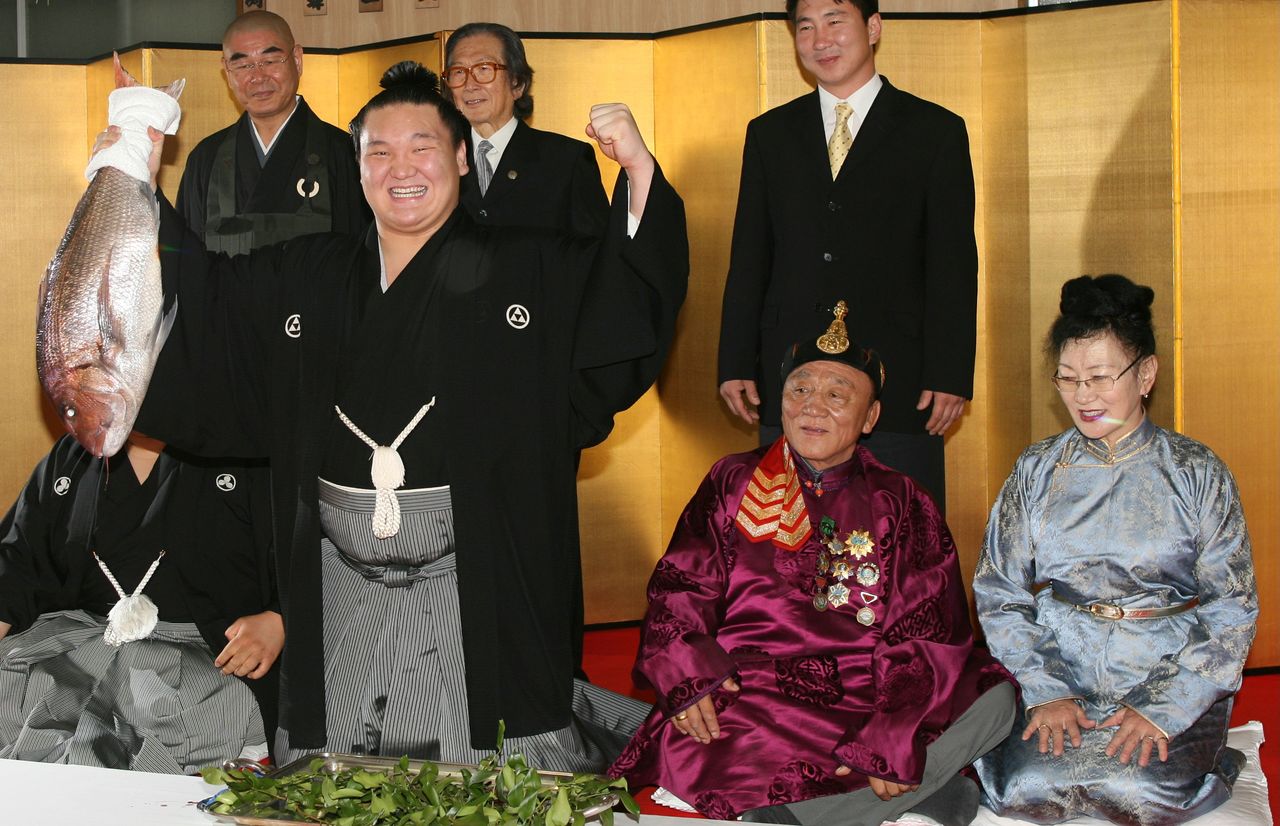
Hakuhō, with a celebratory sea bream in hand, strikes a victory pose during a ceremony at the Miyagino stable on May 30, 2007, marking his promotion to the rank of yokozuna. His parents are seated at the right. (© Jiji)
Shortly after his promotion, Hakuhō participated in a sumō tour in Hawaii, bringing his parents and younger sister along for company. On his free day, he visited a beach near his hotel. Uncharacteristically clad in swimming trunks, he held an impromptu training session with fellow Mongolian and stablemate Ryūō, quipping that he had to “stay in form.”
I watched the pair with interest, and after a while Hakuhō approached me, a mischievous smile on his lips. “You seem to be in pretty good shape for your age. Want to have a go?” he asked. I protested that I was younger than I looked, and then, against my better judgement, took him up on his offer. My 175-centimeter, 70-kilogram frame put me on par with Hakuhō at the start of his career, but the young yokozuna now dwarfed me, standing 192 centimeters tall and weighing in at 155 kilograms. It was going to be a massacre.
Taking up the customary starting position, I charged with all my might. I expected Hakuhō would humor me to a degree, but slamming into his massive frame was like hitting a wall. He did not budge an inch. I quickly wrapped my left arm around his waist and wrangled my right arm around the other side to secure an advantage with a double underarm grip. He could have easily prevented this, but obviously wanted me to feel as if I had a fighting chance.
Things quickly went south from there. Hakuhō leaned in, crushing me with his weight, and then forced his arm under mine. Moving as if to break my grip, he deftly maneuvered his hand to the inside of my thigh, lifted my leg, and flung me through the air. I flew about two meters and landed with a thump on my back in the sand, where I was greeted by a grinning Hakuhō, framed by the blue Hawaiian sky.
Any lingering questions I had as to the strength of sumō wrestlers, particularly a top rikishi like Hakuhō, were answered in spades. The experience of being tossed like a rag doll gave me a first-hand feel of the incredible power the yokozuna wielded, one that went beyond what could be gleaned by watching him in tournaments and training. My articles from then forward would reflect a side of him that only I knew, or so I thought.
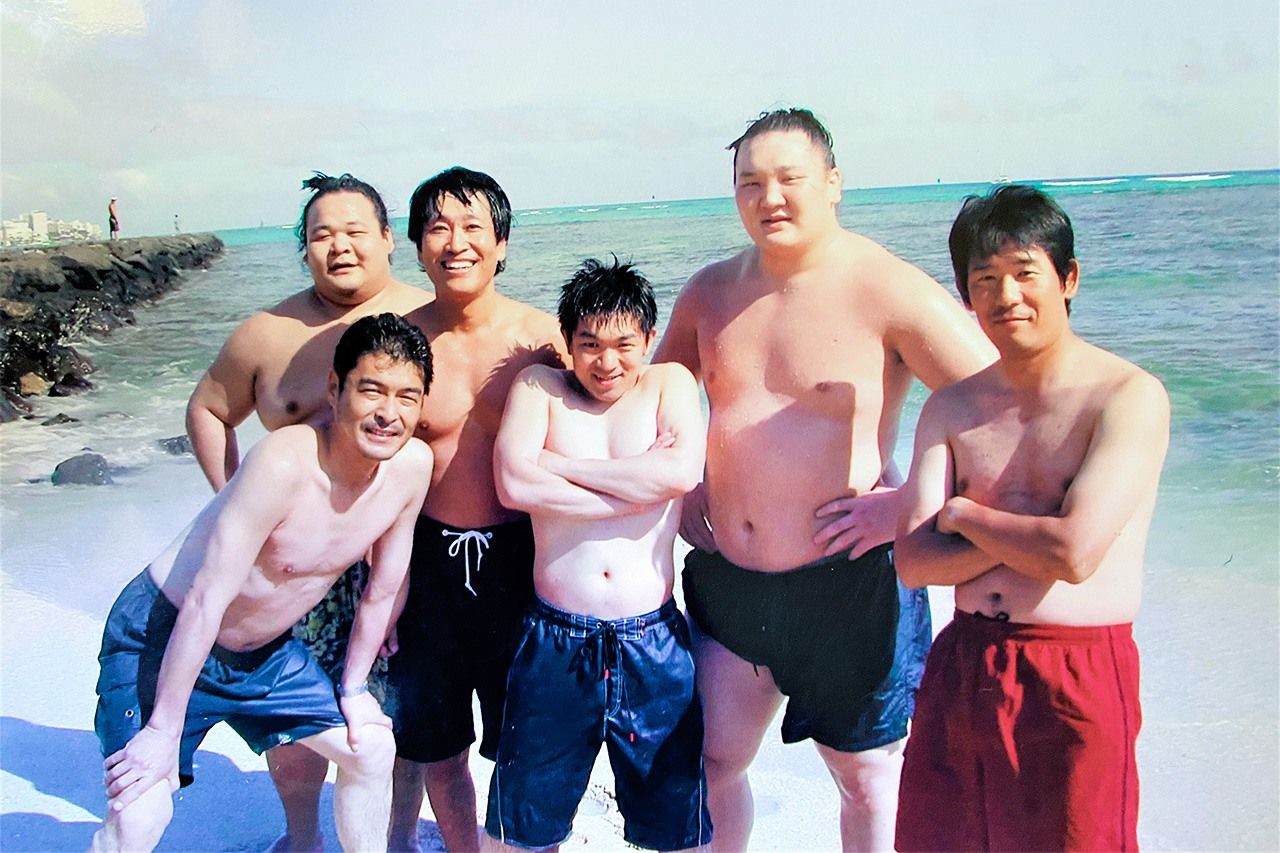
Hakuhō takes a break during a visit to the beach to pose with journalists covering the Hawaii Sumō tour in June 2006. The author is at the back between Hakuhō, right, and Ryūō. (Courtesy of the author)
Passion and Scrutiny
Sumō grand champions are held to very high standards of conduct, and on many occasions Hakuhō came under fire for comments or actions seen as unbecoming of a yokozuna. Take, for instance, an incident on the first day of the 2010 New Year tournament when he inadvertently skipped a crucial part of the dohyō-iri, or ring-entering ceremony.
Each yokozuna dons an ornate rope around his midriff and conducts his own dohyō-iri (video) in which he displays his fierceness with dramatic shiko, high leg raises followed by a foot slammed on the ring floor, resounding claps, and fearsome poses. Hakuhō performed his in the Shiranui style, which is distinguished by a deep squat with both arms held opened. (In the more common Unryū style, the left arm is bent and right extended to the side.) Each yokozuna conducts the ceremony before the start of the makuuchi division matches, and presentations are expected to be flawless.
Hakuhō naturally kept a low stance when wrestling, which was core to his dominance as opponents found it nearly impossible to get him off balance. His pivotal squat during the ring-entering ceremony were similarly deep, and as he slowly rose from the pose, his face intent and arms splayed wide, spectators would erupt into enthusiastic cheers. Onlookers were understandably bewildered when Hakuhō inadvertently skipped the crucial component of the ceremony and merely stood up.
He went on to win his bout that day against Kakuryū, another Mongolian wrestler and eventual yokozuna, and after the postmatch media frenzy died down, I questioned him about the omission. Flashing his usual smile, Hakuhō blurted, “I’d hoped nobody noticed.” He blamed the slip-up on having changed his style of shiko ahead of the tournament. “I was so focused on getting the stomp right that I blanked.” He laughed it off with an embarrassed chuckle, saying that “it’s a bit like a singer singing the wrong verse. You just have to press on.” However, the incident did not sit well with everyone.
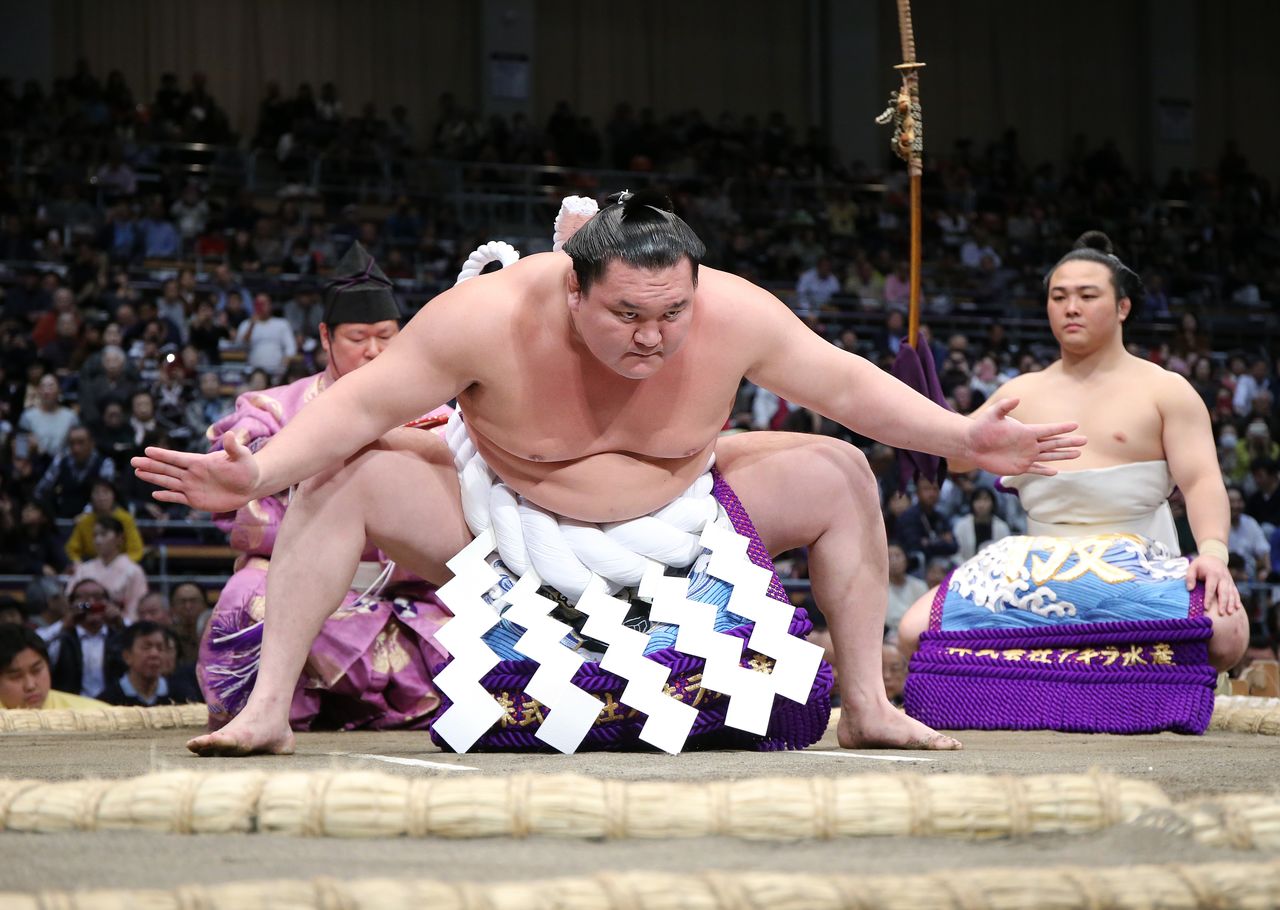
Hakuhō performs a ring-entering ceremony at the Kyūshū tournament on November 18, 2019. In choosing the less common Shiranui style, characterized by both arms held wide as opposed to just one arm in the more popular Unryū style, he dispelled the myth that a yokozuna performing the form is destined to have short career. (© Jiji)
When Hakuhō came under fire for something he said or did, there was a strong tendency to attribute his behavior to arrogance, a view that I do not adhere to. True, he had a youthful, easy-going attitude. But at the same time, he held a deep affection for sumō.
At the root of the issue is the difference in the Japanese view of the rank of yokozuna and that of Mongolian rikishi who have achieved sumō’s highest tier, a divide that can be traced back to the stables where the wrestlers were brought up and the Japan Sumō Association. Prior to Hakuhō, fellow Mongolian Asashōryū was regularly chastised in the press for what was construed as undignified behavior in the ring. However, I would argue that the interpretation of Hakuhō and others as to the lofty role of a grand champion was on target, even if their actions sometimes veered from accepted norms.
Early on, for instance, Hakuhō used potent tactics like kachiage (upward forearm charge) and harite (face slap) to dominate opponents, but stopped later in his career following criticism that such maneuvers were “unsightly” for a grand champion. In doing so, he honored the deeply traditional aesthetic constraints of sumō while maintaining the view that it is the duty of a yokozuna to lead the sport. When he stepped onto the dohyō, it was with the sole intent of winning.
Several years back I had the opportunity to do an exclusive interview with Hakuhō during a sumō tour in Kyūshū, and during our talk he shared a poignant story about a trip to some of the prefectures hardest hit by the Great East Japan Earthquake in 2011. He and a group of wrestlers were in the town of Yamada in Iwate Prefecture to perform a ring-entering ceremony to show support for the recovery effort. “Aftershocks were a constant menace,” he explained. “They made it impossible to sleep through the night.” Explaining to me the significance of the shiko in the dohō-iri as symbolically driving away malicious spirits lurking under the ground, he said that the day after the performance he received a call from a town official. “The person said that the aftershocks had inexplicably stopped after we performed the dohyō-iri ceremony. I was moved by the implication that I had had a hand in bringing the tremors to an end. It gave me a new appreciation of the spiritual significance sumō has in Japanese culture.”
Even as new training techniques like weightlifting have become part of the regime of sumō wrestlers, Hakuhō over his career continued to value traditional exercises like shiko and pushing a large wooden pole called a teppō. He also took a keen interest in the history of the sport, attaining a level of understanding that surpassed many of his Japanese colleagues. He has more than proved himself capable of fulfilling a coaching role as an oyakata, and I look forward to seeing him use his knowledge and experience to guide a new generation of wrestlers.
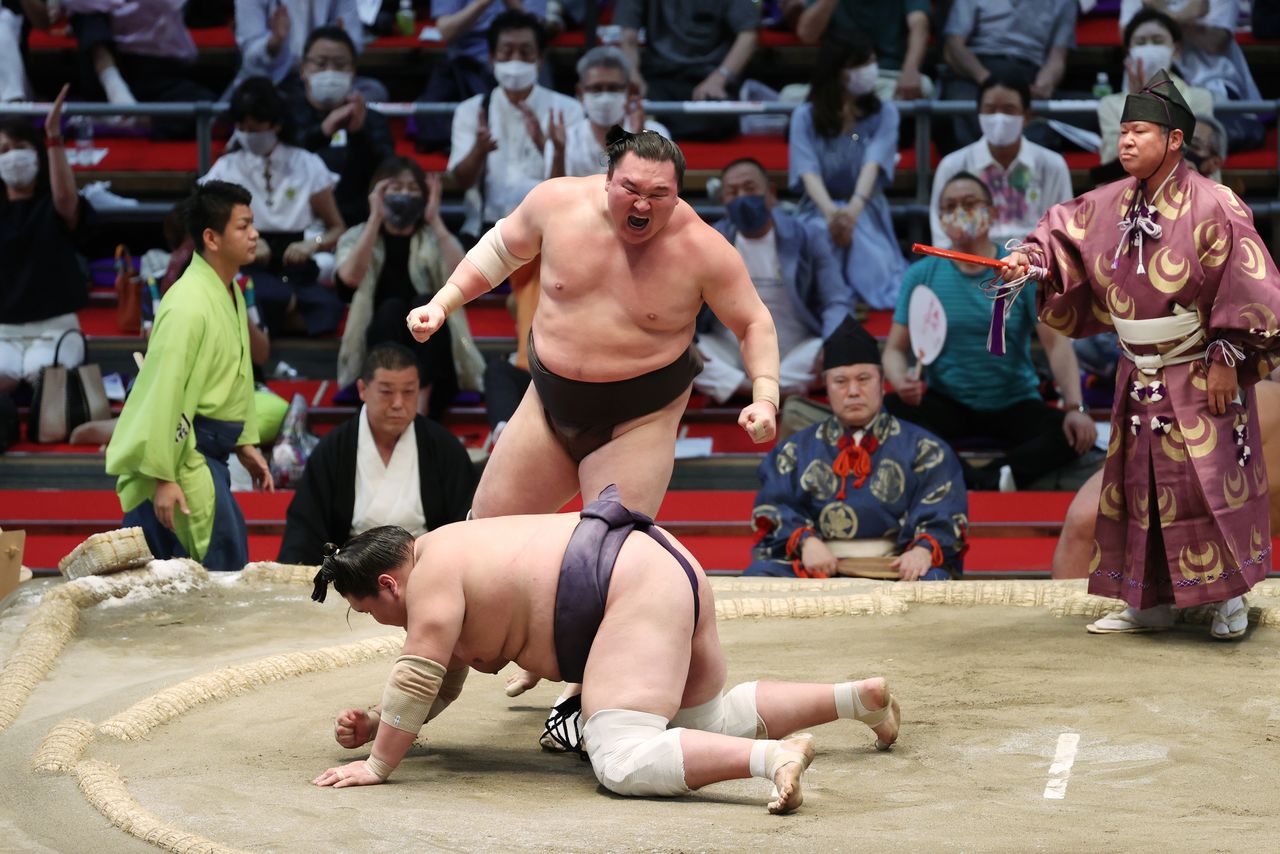
Hakuhō celebrates winning his final bout of the Nagoya tournament against Terunofuji on July 18, 2021, to claim the championship with an undefeated record. It was his last appearance in the ring. (© Jiji)
(Originally published in Japanese. Banner photo: Hakuhō, dressed uncharacteristically in swimming trunks, smiles after tossing the author in an impromptu match on a beach during a sumō tour of Hawaii in June 2007. Courtesy of the author.)